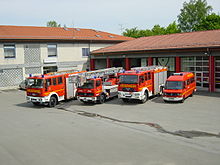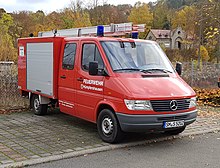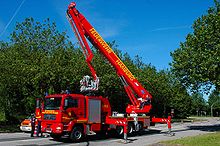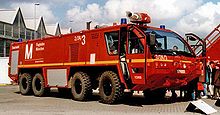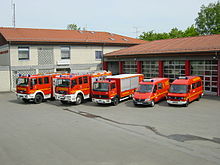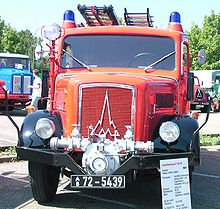Fire fighting vehicles in Germany
In Germany there are special requirements for fire engines . In contrast to the USA , for example , they have to be as multifunctional as possible in Germany. They must be usable in urban regions, forests, heaths and in the mountains and at the same time be used in many conceivable application scenarios. The German Institute for Standardization is standardizing numerous emergency vehicles for easy and unambiguous use, even in supraregional interaction . The corresponding identifier is also contained in the paging name , which, however, does not mean that this identifier is necessarily the same in two federal states, nor does it preclude one federal state from assigning two standard vehicles to one identifier.
Classification
In order to be able to determine the operational value of the fire fighting vehicles, it is necessary to make a classification here. In Germany there are two criteria for this, namely occupation and standardization .
crew
Fire engines can be classified according to the tactical unit that they are manned by. This is particularly necessary for operations with a large amount of personnel in order to be able to ensure that all emergency services can be transported to the site. According to this classification there are 3 types of vehicle:
- The squad car (0/1/2/ 3 ) has 3 crew members: a squad leader, a troop, and a machinists. Among the troop vehicles include rescue vehicles , aerial rescue vehicles , fire trucks , hose reels and equipment trolley .
- The relay vehicle (0/1/5/ 6 ) has 6 crew members: a squadron leader, an engineer and two squads (each squad leader and troop). The relay vehicles include portable fire pumps , tank fire engines and small fire engines .
- The group vehicle ( 0/1/8/9 or 1/0/8/9 ) has 9 crew members: a group leader, a machinist, a reporter and three squads (each with a squad leader and a squad man). The group vehicles include fire fighting group vehicles , emergency fire fighting group vehicles and crew transport vehicles , often multi-purpose vehicles, etc.
In addition, there are special cases such as the command vehicle with four men (1/1/2/ 4 ) crew or various small emergency vehicles with only two man (0/1/1/ 2 ).
standardization
Most emergency vehicles of the German fire brigades are standardized in DIN . The DIN number range DIN 14500 to 14599 and the range DIN 14700 to 14709 for mobile fire brigade ladders are used for this.
Fire engine type list of the currently standardized vehicles
| Vehicle type | short designation |
Pump type | operation area | Total mass |
crew | Minimum tank volume |
|---|---|---|---|---|---|---|
| Portable pump vehicle | TSF | PFPN 10-1000 | Fire fighting | 4.75 t | Relay (0/1/5/ 6 ) | - |
| Small fire engine | KLF | PFPN 10-1000 | Fire fighting | 4.75 t | Relay (0/1/5/ 6 ) | 500 l |
| Portable pump vehicle with water | TSF-W | PFPN 10-1000 | Fire fighting | 7.5 t | Relay (0/1/5/ 6 ) | 500 to 750 l |
| Medium fire truck | MLF | FPN 10-1000 | Fire fighting | 9.0 t | Relay (0/1/5/ 6 ) | 600 to 1000 l |
| Fire fighting vehicle 10 | LF 10 | FPN 10-1000 | Fire fighting / technical assistance | 14 t | Group ( 0/1/8/9 ) | 1200 l |
| Emergency fire fighting vehicle 10 | HLF 10 | FPN 10-1000 | Fire fighting / technical assistance | 14 t | Group ( 0/1/8/9 ) | 1000 l |
| Fire fighting vehicle 20 | LF 20 | FPN 10-2000 | Fire fighting / technical assistance | 16 t | Group ( 0/1/8/9 ) | 2000 l |
| Firefighting group vehicle 20 for disaster control | LF 20 KatS | FPN 10-2000 | Fire fighting / technical assistance | 16 t | Group ( 0/1/8/9 ) | 1000 l |
| Emergency fire fighting group vehicle 20 | HLF 20 | FPN 10-2000 | Fire fighting / technical assistance | 16 t | Group ( 0/1/8/9 ) | 1600 l |
| Fire truck 2000 | TLF 2000 | FPN 10-1000 | Fire fighting | 14 t | Trupp (0/1/2/ 3 ) | 2000 l |
| Fire truck 3000 | TLF 3000 | FPN 10-2000 | Fire fighting | 14 t | Trupp (0/1/2/ 3 ) | 3000 l |
| 4000 tank tender | TLF 4000 | FPN 10-2000 | Fire fighting | 16 t | Trupp (0/1/2/ 3 ) | 4000 l + 500 l foam concentrate |
| Turntable ladder 12 | DLK 12 | - | Rescue technology | 13 t | Trupp (0/1/2/ 3 ) | - |
| Turntable ladder 18 | DLK 18 | - | Rescue technology | 14 t | Trupp (0/1/2/ 3 ) | - |
| Turntable ladder 23 | DLK 23 | - | Rescue technology | 16 t | Trupp (0/1/2/ 3 ) | - |
| Aerial work platform | HAB | - | Rescue technology | 16 t | Trupp (0/1/2/ 3 ) | - |
| Swap body vehicle | WLF | - | logistics | 18 t (with two axles), 26 t (with three axles) | Trupp (0/1/1/ 2 ) | - |
| Rescue vehicle | RW | - | Technical assistance | 16 t | Trupp (0/1/2/ 3 ) | - |
| Equipment trolley for dangerous goods | GW-G | - | Use of dangerous goods | 16 t | Trupp (0/1/2/ 3 ) | - |
| Equipment trolley decontamination personnel | GW decon P | - | decontamination | 10.5 t or 16 t | Relay (0/1/5/ 6 ) | - |
| Equipment trolley logistics 1 | GW-L1 | - | logistics | 7.5 t | Trupp (0/1/2/ 3 ) or relay (0/1/5/ 6 ) | - |
| Equipment trolley logistics 2 | GW-L2 | - | logistics | 16 t | Relay (0/1/5/ 6 ) | - |
| Command car | KdoW | - | Operations management | 3.5 t | Drivers and Platoon Headquarters (1/1/2/ 4 ) | - |
| Command vehicle 1 | ELW 1 | - | Operations management | 4.75 t | Drivers and Platoon Headquarters (1/1/2/ 4 ) | - |
| Command vehicle 2 | ELW 2 | - | Operations management | 16 t | Trupp (0/1/2/ 3 ) | - |
Sources: Fire fighting vehicle conception of DIN-FNFW - fire fighting vehicle type list of the most common vehicles , DIN SPEC 14502-1: 2016-12 fire fighting vehicles - Part 1: Vehicle mass and vehicle overview
Command vehicle
Command vehicles (ELW) transport the operations manager to the site and help him to coordinate the measures. To do this, they transport various cards, radios, reference works and other guides.
Currently three command vehicles are standardized: KdoW ; ELW 1 ; ELW 2
In addition, there is an even larger ELW 3 or a roll-off container for operations management at larger professional and plant fire departments . Some fire departments find even Zugtruppkraftwagen (ZTrKW), executive cars (FüKW) and radio squad cars (FuTrKW) of the Civil Protection held use. However, these vehicles are not (no longer) standardized in Germany.
Fire trucks
Fire trucks carry a fire brigade load with them for fire fighting. These are in particular pumps, hoses, nozzles and usually a water tank, in addition to other technical equipment. Your primary task is to fight fires.
Portable fire pumps
Portable fire pumps (TSF) are small fire fighting vehicles with a fire fighting equipment for fire fighting. With a squadron crew and a maximum permissible total weight of 3.5 t, they are light emergency vehicles that are used especially for smaller volunteer fire brigades . They do not have a permanently installed pump, but transport a PFPN 10 1000, which is loaded on a slide in the rear of the vehicle. The TSF only has a squadron crew, but material for a complete fire fighting group on board.
At present 2 portable pump vehicles are standardized: TSF ; TSF-W
Not infrequently, however, one also sees TSAs which are attached to other vehicles and pulled to the scene of action. They have similar fire-fighting equipment as the TSF, but are no longer standardized.
The GW-TS (RP) portable pump equipment trolleys also belong to the group of portable fire pumps . This is a vehicle in accordance with DIN 14502 Part 1. The vehicle designed for a squad with a maximum mass of 2,700 kg is designed to accommodate a portable pump PFPN 10 10 and is an alternative to the portable pump trailer.
Small fire engine
Small fire engines (KLF) initiate initial fire fighting measures or fight incipient fires. The small fire truck KLF is a fire truck with at least one portable pump PFPN 10-1000 according to DIN EN 14466, a device for the quick release of water, a fire-fighting water tank with a usable amount of water of at least 500 l and a firefighting equipment is a group (0/1/8/ 9 ). The crew consists of a relay (0/1/5/ 6 ). The vehicle is mainly used for fire fighting and forms an independent tactical unit with the crew that has been added to the group. The maximum length is 6,000 mm, the maximum width is 2,300 mm and the maximum height is 2,600 mm. The permissible total weight of the KLF is limited to 4,750 kg. A standard box van or a standard chassis with a double cabin is used for the vehicle, and road drive (Str) should be selected as the type of drive. The maximum speed of the KLF is 100 km / h for safety reasons. The revision of DIN 14530-24: 2004-11 had become necessary in order to adapt the technical content to the changed conditions of the driving licenses. To this end, the following changes have been made: a) The term small fire engine KLF revised; b) the gross vehicle weight increased to 4 750 kg; c) maximum speed limited to 100 km / h; d) the content of the extinguishing water tank increased to at least 500 l; e) portable pump changed, added PFPN 10-1000 and expanded the requirements; f) Replaced the multi-purpose jet pipe with the hollow jet pipe in the device for rapid water delivery. The DIN 14530-24 was adapted in September 2012. Due to the new classification, the vehicle is also suitable for internal attacks, but a permanent water supply must be built up.
In addition to the standardized KLF, there are numerous self-built fire brigades with the same name.
Medium fire truck
Medium fire fighting vehicles (MLF), called "relay fire fighting vehicle " (StLF) according to the old DIN standard, are quite young vehicles standardized according to DIN 14530-25, which are to be classified between LF 10 and TSF-W. This closes the gap for small and medium-sized fire departments with the need for a small, standardized universal vehicle. The vehicle is manned by a relay and has a max. 7.5 t total weight. It has a water supply of at least 600 liters, extensive extinguishing equipment and, to a small extent, equipment for technical assistance. It is mostly designed as a road vehicle without all-wheel drive in order to hold the 7.5 t total weight.
Fire fighting vehicles
Fire fighting vehicles (LF) form the support of every fire fighting operation . They transport a large part of the fire-fighting equipment, with a group crew a considerable part of the crew and one or two centrifugal fire pumps . Thanks to the built-in tank and its rapid attack device , an initial fire attack can also be carried out without a water supply.
Currently three fire fighting vehicles are standardized: LF 10 and LF 20 as well as fire fighting vehicle 20 for disaster control .
An exception is the state of Lower Saxony, where vehicles for special requirements are approved with so-called technical instructions. For example, according to technical instruction 14, the LF 8 is an LF 10 without a water tank, which creates a weight reserve that can be used for extended loading, for example. B. can be used in the field of technical assistance.
The fire fighting group vehicles according to the old (pre) standard are widespread: LF 8 , LF 8/6 , LF 10/6 ; LF 16 , LF 16/12 , LF 20/16 ; LF 24 . There is also an LF 16-TS with a portable pump , which was primarily procured for disaster control . Its load includes u. a. 600 m of B-hoses. The standard successor is the above LF 20 KatS. In the earlier naming of fire engines, LF stands for fire fighting vehicle and the number in front of the slash for the power of the centrifugal fire pump (20 for a nominal delivery rate of at least 2000 liters per minute at a nominal delivery pressure of 10 bar), the number after that for the water tank volume in hundred liters.
The Hamburg fire-fighting vehicle represents a non-DIN-standardized special route , which is abbreviated as HLF, but should not be confused with the emergency fire-fighting group vehicle.
Emergency fire fighting group vehicles
Emergency fire fighting group vehicles (HLF) are more likely to be found at large fire brigades and are characterized by the fact that the load for fire fighting is supplemented by equipment for technical assistance.
Currently only HLF 10 (formerly HLF 10/6) and HLF 20 (formerly HLF 20/16) are standardized.
The emergency fire fighting vehicle is based on the emergency fire fighting vehicles, which were standardized in Hesse, but are also being replaced by the new standard. In addition, there are 14 copies of the HLF 24/14-S nationwide in Germany , which was procured by Deutsche Bahn for long old tunnels; however, this is not standardized.
Fire trucks
Tank fire engines (TLF) are primarily used to carry out a rapid attack with various extinguishing agents and to supply the emergency site with extinguishing water for a longer period of time, if necessary also in shuttle traffic. This is often necessary in the case of forest fires .
TLF transport part of the fire-fighting equipment. The new vehicle types with a squad 0/1/2/ 3 occupied, older standards also saw fire trucks with relay crew 0/1/5/ 6 before. This means that under certain circumstances they can also be used to cause minor damage, e.g. B. burning garbage cans, move out.
There are currently 3 fire trucks standardized: TLF 2000 , TLF 3000 , TLF 4000
The TLF 24/50 , the TLF 16/24-Tr , the TLF 20/40 and the TLF 20/40-SL used to be standardized. The tank fire engines according to old standards are also widespread: TLF 8/8 , TLF 8/18 and TLF 16/25 .
There are also large tank fire engines (GTLF). In Brandenburg, the TLF 16/45 was also specially designed for fighting forest fires. Lower Saxony's vehicle to fight forest fires was the TLF 8W .
Aerial rescue vehicles
Aerial rescue vehicles are used to rescue people from exposed locations or as an attack route into exposed locations, but also as light masts or water cannons. Their fire brigade load is comparatively small, instead they have a telescopic arm or a ladder park.
Turntable ladders
Old abbreviation : turntable ladders (DL / DLK) are the best known and most common aerial rescue vehicles. They can be used to guide higher floors. The abbreviation DL stands for "turntable ladder". The abbreviation DLK still stands for “turntable ladder with rescue cage ”.
New abbreviation : DLA (K) or DLS (K) corresponds to the turntable ladder A utomatik (with basket) or ladder S equentiell or semi-automatic. The DLA turntable ladders can carry out several lifting movements at the same time, the DLS turntable ladders only one. Since the DLS cannot meet its set-up time, only DLA turntable ladders are purchased in Germany.
The norms for the nominal rescue height and nominal extension remain.
Currently 3 turntable ladders are standardized as aerial rescue vehicles:
the DL 16-4 with manual drive is not an aerial rescue vehicle, but is still standardized.
There are also other turntable ladder types that correspond to DLK 23-12, but have a longer ladder pool and are therefore not standardized: DLK 37 ; DLK 44 ; DLK 53
Ladders
Towed ladders ( AL ) are fire service trailers that transport a pool of ladders. They are mainly used by smaller fire brigades that cannot finance an aerial rescue vehicle, but also cannot recruit one from the area if necessary. No AL is currently standardized.
Telescopic masts
Telescopic masts ( TM ) are modern aerial rescue vehicles, which are more stable than the turntable ladders and can also reach more exposed positions (e.g. windows on the opposite house wall). Turntable ladders usually weigh between 14 and 15 t, while telescopic masts usually weigh 18 t (stripped-down versions with a slightly shorter reach have 16 t). In Germany, fire brigade installation areas (installation areas for turntable ladders) only have to be able to carry 16 t.
An important criterion to distinguish between telescopic masts is whether they have a ladder attached parallel to the mast. Vehicles with such a ladder can in principle replace the classic turntable ladder.
However, telescopic masts require a significantly longer set-up time (erection time) than turntable ladders. In this respect, turntable ladders are usually the faster and therefore more suitable rescue device.
Larger telescopic mast vehicles usually do not have such a ladder and are used in special cases and only in addition to turntable ladders. Examples are the TMF of the Hamburg fire brigade with a height of up to 53 meters and a weight of 35 t, the TMF of the Dortmund fire brigade with a height of up to 55 m or the TM 50 of the Berlin fire brigade with a working height of 50 m.
Equipment and equipment trolleys
Equipment and equipment trolleys carry special material and equipment for technical assistance (e.g. for traffic and hazardous material accidents). They usually only have a small crew.
Rescue vehicle
Emergency vehicles (RW) are fire fighting vehicles for technical assistance on a larger scale. They have all-wheel drive, a winch, a generator and a variety of devices. With their load they deliver the equipment for the armor train .
There is currently a standard for only one rescue vehicle . The rescue train usually consists of a command vehicle, rescue vehicle, rescue vehicle and other vehicles (for example, a fire brigade crane, if available ).
Of course there are still many older rescue vehicles in three old size units (standard change was in 2002): RW 1 ; RW 2 ; RW 3 (RW 3 out of the norm for a long time).
Equipment trolley
Equipment vehicles (GW) are fire fighting vehicles for technical assistance. They can have four-wheel drive and usually carry highly specialized equipment with them. Based on this equipment, they can be assigned to different purposes.
There are currently three DIN-standardized equipment trolleys: Logistics equipment trolleys GW-L1 and GW-L2 as well as the hazardous goods equipment trolley (GW-G)
The GW-G1 , GW-G2 , GW-G3 are no longer standardized, but are still widely used ; GW-Öl and the SW 2000-Tr . There are also numerous other, non-standardized equipment trolleys.
Fire engine
Fire brigade cranes (FwK), which are intended in particular for lifting heavy loads and for supporting heavy technical assistance, are also not standardized .
Swap body vehicles / roll-off containers
Swap loader vehicles (WLF) are special vehicles for the transport of roll-off containers (AB) with a specific fire-fighting equipment load. They have a crew and usually form an independent tactical unit with the loading of the respective container. Since this principle is very economical, it is preferred by more and more fire departments.
Quite common roll-off containers are: AB Operations Management, AB Pumps, AB Mulde, AB Breathing Protection, AB Hazardous Goods, AB Special Extinguishing Agents, AB Armaments.
Swap loader vehicles can also be equipped with a crane, see Swap loader vehicle with crane .
Ambulance vehicles
Rescue equipment is used for emergency rescue and ambulance transport , depending on local legislation, also under the operators of organizations other than the fire brigade.
The are standardized ambulance , ambulance , ambulance (all in the DIN EN 1789 ) and the emergency doctor vehicle ( DIN 75079 ).
Other ground-based rescue service vehicles are, for example, intensive care vehicles , large-capacity ambulances , transfer doctors' vehicles and, in Essen, the fire-fighting vehicle .
other vehicles
In addition to the vehicles mentioned above, there are numerous other fire service vehicles that are currently not standardized nationwide, e.g. B. MTF , multi-purpose vehicles and FwK .
Not standardized fire engines
Reasons for non-standardized vehicles
Non-standardized vehicles can be found at a large number of fire departments. There have been long discussions about the pros and cons of standard vehicles. From the point of view of the advocates of individual solutions, only these offer the possibility of taking into account all so-called local conditions. In contrast, critics of custom solutions argue that they create more problems than they solve and that there are not so many different local conditions. The problem of the tactical maneuverability of individual vehicles in the event of major damage is undisputed.
It is very common to find non-standardized vehicles at plant fire departments. These often require specially equipped vehicles with a very special and restricted area of application. Individual solutions can often do this better than standardized vehicles, which is why expensive custom-made products are often procured that meet these requirements. The same applies to airport fire brigades according to ICAO .
Funding with funds from the corresponding federal state does not take place here .
Advance vehicles
Advance vehicles often have a smaller load. They can be designed very differently and usually carry out initial measures during deployment until the heavy emergency vehicles arrive. There is no uniform standard for these types of vehicles.
Pre-equipment vehicles, pre-equipment vehicles and fire-fighting vehicles are quite common.
Small emergency vehicles
Small emergency vehicles (KEF), locally also known as small alarm vehicles (KlAF), are equipment vehicles for handling small emergency measures. Crew and equipment can differ fundamentally. Due to the range of applications, this type of vehicle is very often used by urban professional fire departments.
Special fire engines
Special fire engines (SLF) are fire engines for special fire fighting. They can usually only be found at highly specialized plant fire brigades or very large fire brigades and differ fundamentally from conventional fire fighting vehicles with their specific properties. These vehicles include B. Airfield fire fighting vehicles (FLF), fire fighting tanks , foam fire fighting vehicles and aerosol fire fighting vehicles (also known as "turbo fire extinguishers ").
Dry (-tank) fire-fighting vehicles
Dry fire-fighting vehicles (TroLF) and dry tank fire-fighting vehicles (TroTLF) are special fire-fighting vehicles that fight fires that cannot be extinguished with other established extinguishing agents. In addition to conventional equipment, they also have a powder extinguishing system and a large extinguishing powder container. Since these vehicles are very expensive to purchase and are rarely used, they can only be found in larger professional or plant fire departments . There are also various other powder fire engines or dry fire engines, which were mostly developed and built by their owners themselves.
Fire fighting vehicles with powder extinguishing systems as first attack vehicles were introduced into DIN standardization in 1971 with the TroTLF 16, because at the time it was widely believed that fire extinguishing powder could often work more efficiently and effectively than with water and extinguishing foam. In practice, however, it turned out in many places that the powder extinguishing system was used far less often than anticipated.
The standardization of fire fighting vehicles with powder extinguishing systems was abandoned in Germany in 1991 (withdrawal of the TroLF 750 standard : 11/1988; withdrawal of the TroTLF 16 : 10/1991 standard ). Nowadays, in some places extinguishing powder supplies are kept on roll-off containers, which is cheaper.
other vehicles
In addition to the vehicles mentioned above, the fire brigade sometimes operates other vehicles that cannot be assigned to these groups; this includes the field cooker and the motorcycle .
Civil protection vehicles

Disaster control vehicles (KatS) form a separate category . Most of them are not standardized according to DIN, but are described by the Federal Office for Civil Protection and Disaster Relief in a procurement application, procured centrally and delivered to aid organizations throughout Germany. The vehicles remain the property of the federal government. The procurement requests are usually more specific than vehicle standards, as they contain specific chassis and superstructures, engines and loads.
The fire brigades are responsible for fire protection and NBC defense in disaster control. While in the 1950s and 1960s complete specialist trains for fire fighting and water supply were made available by the KatS, today almost only special vehicles are procured, the acquisition of which would hardly be profitable for individual communities. They are designed for joint use in major incidents, but are also available to the respective fire brigade for normal operations.
The fire protection area of the KatS still includes the LF 16-TS and the SW 2000-Tr .
In 2009, Lentner received an order from the Federal Office for Civil Protection and Disaster Relief (BBK) to build 70 new fire fighting group vehicles 20 KatS (with the option of 120 more) and car + camper kiel GmbH received an order for 70 KatS hose trolleys (with the option of 95 more). The BBK plans to procure a total of 961 fire fighting vehicles and 450 hose trolleys.
The tasks of NBC protection include the ABC ErkKW , the decontamination truck P and the DMF , which as a placeholder for the planned decontamination truck G serves.
Vehicles that are no longer needed in the KatS are often bought up and reused or converted by the communities where they were stationed. Some RW 1s as well as FuKW , FüKW and FeKW from the 1970s and 1980s are still in use today .
In addition to these fire-fighting vehicles, disaster control also includes medical service , care service and catering vehicles, which are used by various organizations.
Rail vehicles
Rail-bound rescue equipment, usually a train consisting of one or more locomotives and special wagons, can be used in the event of accidents on or on railway lines. They are not fire engines in the strict sense. These trains, usually as a rescue train , Firefighting and rescue designated or Tunnelhilfszug are positioned in central locations and be occupied in case of need of train drivers, ambulance and fire department. They serve as support for the local rescue workers who are always approaching.
There are also fire-fighting vehicles such as the emergency fire-fighting vehicle 24/14-S , which can drive on railway tracks using a rail wheel set and are primarily intended for use in tunnels.
Fire truck trailer
Fire brigade trailers (FwA) are used to transport devices to the deployment site. They are used especially in smaller fire brigades that cannot afford the vehicles on which these devices would normally be loaded. The only (still) standardized trailers are the trailer with foam water cannon (FwA-SWW) and the boat trailer (for multi-purpose boats ( MZB), lifeboats (RTB1 and RTB2) etc .; DIN 14962).
Also relatively widespread are multi-purpose trailers (MZA), portable pump trailers (TSA), powder fire-fighting trailers , oil service trailers (oil damage trailer ÖSA), road safety trailers ( VSA), hose transport trailers (STA), light mast trailers (FwA-Lima) and ladders (AL; see also section "Towed ladders") in this article ).
Fire boats
The following types of boats are used by fire services: multi-purpose boats (MZB) and their special forms, fire boats (LB) and lifeboats (RTB1 and RTB2). The MZBs and RTBs are standardized according to DIN 14961.
Formation of trains
In everyday fire services, different types of vehicles are used in combination, depending on the task at hand. Such vehicle combinations are referred to as a train according to fire service regulation 3 . The most well-known form of a fire brigade train is the fire fighting train , which in many places consists of a command vehicle, an aerial rescue vehicle and two fire engines. According to the fire brigade service regulations, a train has a target strength of 22 men, which is seldom achieved exactly by volunteer fire brigades, as the availability of the staff depends on many factors. For cost reasons, many professional fire brigades have also started to assemble their trains from the mandatory vehicles, but according to a recommendation of the working group of heads of professional fire brigades, they have only 14 emergency personnel. A fire fighting train can be supplemented by a maximum of one further group and is then referred to as an extended train.
In addition to the fire fighting train, trains are also set up to deal with other emergency situations. Many fire brigades have a rescue or rescue train that moves out to cause particularly serious traffic accidents. The vehicles from which this is made up is subject to strong local fluctuations, but at least one rescue vehicle and one fire engine are usually part of this train. In many counties there are dangerous goods trains , which are regularly made up of various special vehicles to identify and remove dangerous goods and to protect the crew, as well as at least one command vehicle and a fire engine.
Fire brigades, which have to reckon with special situations in their area of operation, have often set up other vehicle combinations as a train. For example, there are also water rescue trains (not identical to those of the water rescue service and the DLRG) or forest fire trains, the composition of which, however, cannot be represented in a generally applicable manner.
The vehicles that make up a train are regulated in the so-called alarm plan .
technology
pump
When it comes to pumps that are permanently integrated in the vehicle, a distinction is made between front pumps and rear pumps . Front pumps are used in those types of vehicles in which a second pump is inserted in the rear or which are to drive straight ahead to a water intake point (e.g. LF16-TS). In the case of newer models, there is a general move towards installing permanently integrated pumps in the rear and accommodating another pump in a device room on the side, as the pump can thus be connected to a tank and is better protected.
If there is only one pump, it is usually installed in the rear behind the water tank. There, the lengths of the pipelines from the tank to the pump are short, and in confined areas the operator is usually more secure behind the rear of the vehicle than on the side.
Alarm devices
Today all fire fighting vehicles in Germany have a special signaling system , consisting of a sequential horn and blue light . This goes back to the 1930s, when the identification by alarm bell, blue light and siren was ordered for the first time. The blue light was stipulated in the road traffic regulations as early as 1937 , but it was not until 1938 that the Max B. Martin company horn and blue identification lights were prescribed for the vehicles of the fire-fighting police at the time . With this decree, the tone sequence of the sirloin was also set to a regular sequence of two tones spaced a fourth apart (a 'and d'). In addition, a ring signal could be used by fire police vehicles.
In the years that followed, the signaling equipment was further standardized. But it was not until March 29, 1956, that the flashing light still used today was prescribed instead of a permanent blue light.
Wireless
Fire fighting vehicles are usually equipped with a radio for communication between the individual rescue workers . In analog radio technology, the so-called 2-meter band , primarily for emergency site radio with handheld radios, and the 4-meter band for communication between the vehicles and with the control centers are used here. The switch to digital radio is planned nationwide and is currently (as of 2018) already completed in some federal states, while other federal states are still in the planning phase. It is hoped that this modern system will provide better and trouble-free communication in the future, even across district and national borders.
history
Fire engines before the First World War


The first fire engines were made by hand and were based on the construction of carriages and wagons. Up to the end of the 19th century, there were essentially only two types of fire fighting vehicle: the syringe truck and the extension ladder, which were pulled to the scene either by horses or by the crew themselves. They were made of wood and operated by muscle power, which is why you could not always rely on them in action. As a result of industrialization, the fire brigades became more mechanized and motorized, but only very hesitantly because the firefighters had concerns about approaching fires with gasoline-powered vehicles. The history of modern fire fighting vehicles begins in 1902 when the Freiburg company Grether & Cie. built the world's first fire engine with a combustion engine. The next milestone came in 1904, when Magirus (later Magirus-Deutz and now Iveco Magirus ) built the first motor-driven turntable ladder , which, however, still had to be extended by hand. Motor pumps followed shortly afterwards, which helped the Magirus company to gain economic growth. At that time, other manufacturers of fire-fighting technology also began to install fire-fighting equipment on truck chassis.
Main article: Fire engine
Fire fighting vehicles after the First World War
After the First World War, the foundations for modern fire services were created. The vehicles became better, more diverse and more modern. Rules and regulations were laid down how they should look and be used. Especially during the time of National Socialism their development experienced a boost. As early as March 1, 1937, it was ordered that the fire engines should be painted pine green. From November 23, 1938, the fire brigade was subordinated to the police throughout the Reich. The professional fire brigades were renamed the fire protection police. The volunteer fire brigades became technical auxiliary forces of the police, but kept the designation of the volunteer fire brigade . In addition, military fire brigade units, the security and auxiliary service (SHD) were created. Uniform building regulations were issued from February 16, 1940, whereby, among other things, a distinction was made between three fire fighting vehicles: light fire fighting vehicle (LLG, later LF 8), heavy fire fighting vehicle (SLG, later LF 15) and large fire fighting vehicle (GLG, later LF 25). On August 14, 1942, the order followed that all vehicles should be delivered in black-gray matt (RAL 7021). From April 7, 1943, the paintwork was changed to yellow-gray-matt (RAL 7028) by decree.
Fire engines after World War II
In the Federal Republic of Germany


After the Second World War , many of the fire fighting vehicles still used today were developed. These include most of the fire fighting vehicles, tank fire engines , turntable ladders, equipment and equipment vehicles as well as the portable pump trailers . A special feature was the LF 16-TS , which was designed with a front-mounted pump so that it could e.g. B. approach open water straight ahead and could promote the water. Over time, the vehicles have been refined and improved. For the technical development and important innovations of importance were (and are) numerous manufacturers of fire fighting vehicles, who developed and produced new technologies for operational readiness. Particularly in view of an impending war with nuclear weapons , NBC defense components were particularly promoted. From experience from forest and field fires , larger or more off-road tank fire engines and hose trucks have been developed.
Long and short-nosed hoods from Magirus-Deutz , MAN and Mercedes-Benz shaped the typical appearance of fire fighting vehicles for a long time : In the 1950s and 1960s, Magirus-Deutz was the undisputed market leader in the fire service sector with its round and corner hoods. Short-nosed vehicles from MAN and Mercedes-Benz were procured for new acquisitions in disaster control until the mid-1990s, as they had a lower overall height than forward control vehicles and were therefore also suitable for air transport . It was only in the 1970s that the front-wheel drive caught on with fire brigades, 10 to 20 years later than in civilian trucks .
In the course of time, the demands placed on the vehicles increased, so that newer and larger types were developed, which, however, were more and more similar: fire fighting vehicles received a rapid attack device and a tank, tank fire fighting vehicles a hydraulic rescue set . At the same time, however, there were also certain differentiations, e.g. B. with turntable ladders: From 1980 there were new types of turntable ladders with a low cab in front of the front axle in order to achieve a lower overall height of the vehicle. This was particularly useful for use in narrow city centers.
In the DDR
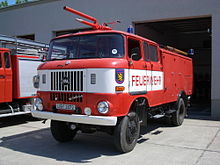
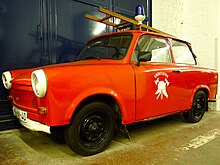
The development of fire engines in the GDR began in 1949 with the production of trucks in the VEB Horch Automobilwerk Zwickau in the VEB Phenomenon factory in Zittau.
Fire fighting vehicles LF 10 and LF 15 were the first fire fighting vehicles in the GDR , it took until 1962 until the first turntable ladder (DL 25). There was a strict standardization according to TGL (comparable with DIN) for emergency vehicles .
There were three main locations for the production of fire engines:
- In Luckenwalde the successor of the Koebe company, the VEB Feuerlöschgerätewerk Luckenwalde (now Rosenbauer)
- in Görlitz the VEB Feuerlöschgerätewerk Görlitz , formerly the company GA Fischer and
- in Jöhstadt the VEB fire extinguishing equipment factory in Jöhstadt , predecessor was the Flader company.
Fire engines today
In the course of time, it has been recognized that the variety of standardized and non-standardized vehicles makes it increasingly difficult to keep track and to correctly assess their operational value. For this reason, new standards for fire fighting vehicles were issued in 2005, which only recognize 12 vehicles as worthy of standardization. In particular, similar vehicles of different sizes are combined into one vehicle type. The largest manufacturers of fire fighting vehicles in Germany today are the companies Magirus , Metz Aerials , Rosenbauer Group , Schlingmann and Ziegler . There are also other smaller bodybuilders such as B. BAI , Gimaex-Schmitz and Lentner .
In February 2011, the Federal Cartel Office disclosed the so-called fire engine cartel on the German market and imposed fines totaling € 68 million on the manufacturers Rosenbauer, Iveco Magirus Brandschutztechnik, Ziegler and Schlingmann .
See also
literature
- Josef Schütz: The Red books, Issue 8 - Fire trucks Part I . 11th edition. Kohlhammer, Stuttgart 1996, ISBN 978-3-17-013954-1 .
- Josef Schütz: Die Rote Hefte, Booklet 8b - Fire fighting vehicles Part II . 11th edition. Kohlhammer, Stuttgart 1996, ISBN 978-3-17-014285-5 .
- Wolfgang Jendsch: Fire fighting vehicles in Europe . Haus Verlag, 1991, ISBN 3-88776-048-4 .
- Wolfgang Jendsch: BRAND - The fire departments of the world . Weltrundschau Verlag, various articles about fire engines from all over the world in the individual book editions.
- Wolfgang Jendsch: Fire brigades - special vehicles from all over the world . Motorbuch Verlag, 2006, ISBN 3-613-02601-5 .
- Wolfgang Jendsch: Modern fire engines from all over the world . Motorbuch Verlag, 2009, ISBN 978-3-613-02601-8 .
- Wolfgang Jendsch: Fire service vehicles - fighting forest fires . Motorbuch Verlag, 2009, ISBN 978-3-613-03033-6 .
- Walter Hamilton, Ulrich Kortt, Rolf Schmid: Handbook for the firefighter. 20th edition. Boorberg Verlag, 2004, ISBN 3-415-03176-4 .
- Hans Kemper: Vehicle customer . Ecomed Verlag, ISBN 3-609-62105-2 .
- State Fire Brigade School Baden-Württemberg: Engineer for fire engines . Neckar-Verlag, 2002, ISBN 3-7883-1966-6 .
- Axel Johanßen: Book series vehicles of the fire brigade (2008/2009 current: Volume 11, ISBN 978-3-939673-04-0 , FdFw-Verlag, Cologne).
- Axel Johanßen: German fire engines from 1990 to today. Bassermann-Verlag, 2007, ISBN 978-3-8094-2175-7 .
- Udo Paulitz: Book series old fire brigades. Franckh-Kosmos, Stuttgart.
- Manfred Gihl: History of the German Fire Brigade Vehicle Construction , Volume 1, From the beginnings to 1940: How the fire brigades became mobile. Kohlhammer Verlag, Stuttgart 1996, ISBN 3-17-014289-5 .
- Manfred Gihl: History of the German Fire Brigade Vehicle Construction , Volume 2, From 1940 to today: How the fire brigades are mobile. Kohlhammer Verlag, Stuttgart 2000, ISBN 3-17-014290-9 .
14285
Web links
- Fire brigade museums in Germany
- Photos and descriptions of fire engines
- Collection of BOS vehicle photos
- Picture collection with brief information on fire engines
- Technical recommendation of the German Fire Brigade Association "The tendering and procurement of fire fighting vehicles" from August 11, 2017
Individual evidence
- ↑ DIN 14505: 2015-01 Fire fighting vehicles - Swap body vehicles with roll-off containers - Supplementary requirements to DIN EN 1846-3
- ↑ Fire engine conception of the DIN-FNFW - fire engine type list of the most common vehicles , as of April 30, 2014.
- ↑ Feuerwehr.de: Communication from September 15, 2006
- ↑ New fire fighting group vehicles for disaster control ( memento of May 29, 2010 in the Internet Archive ), Federal Office for Civil Protection and Disaster Aid, May 13, 2009.
- ↑ The hose trolley for disaster control (SW-KatS) will soon go into production ( Memento from September 5, 2009 in the Internet Archive ), press release from September 1, 2009, Federal Office for Civil Protection and Disaster Aid
- ↑ New fire protection vehicles for disaster control ( page no longer available , search in web archives ), press release from October 27, 2008, Federal Office for Civil Protection and Disaster Aid
- ↑ The history of German truck construction. Weltbild Verlag, 1994, ISBN 3-89350-811-2 , pp. 60, 81.
- ↑ Bundeskartellamt: Press release of February 10, 2011: Bundeskartellamt imposes fines of millions on manufacturers of fire fighting vehicles ( memento of May 1, 2012 in the Internet Archive ), accessed on April 14, 2012.
